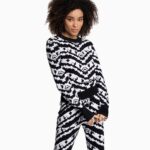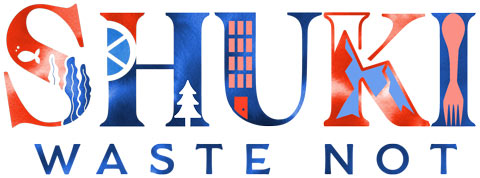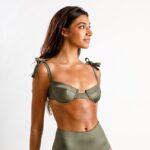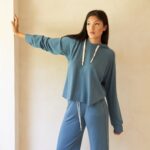What You Should Know About Fabrics and the Environment
- Fashion is widely considered to be the second most polluting industry in the world, behind oil.
- Whereas most mass-produced fabrics cause a range of environmental issues from deforestation to water contamination and microplastics, sustainable fabrics are those that are ethically sourced, sometimes organic or regenerative, often naturally derived, and made with as little environmental impact as possible.
- Here's what you should know about sustainable fabrics so you can better sniff out the greenwashers.
Sustainable fabric is a category of textiles derived from eco-friendly sources—typically fiber crops. When you think of sustainable fabric, you may think of linen, hemp, bamboo, or anything labeled as “recycled” or “organic.” More innovative materials may even be made from food waste, like apple skins, wine industry biomass, and pineapple leaves.
Fabric production affects the environment in a multitude of ways, from the land and water it uses to the way it’s dyed and treated, and, ultimately, how it breaks down at the end of its life. All of these must be considered when assessing a fiber’s footprint. Here’s what you need to know about sustainable fabrics, starting with the two top-level classes of fiber: natural and synthetic.
Natural vs. Synthetic Fibers

Natural fibers, by definition, are either animal-derived or produced through geological processes (i.e., they come from plants). Examples of natural fibers include cotton, wool, silk, bamboo, hemp, linen, and leather.
Synthetic fibers, on the contrary, are made from chemical compounds. There are also semi-synthetic fibers that are derived from natural raw materials but go through a chemical process. Examples of synthetic fibers include nylon, polyester, and rayon (semi-synthetic).
Environmental Issues Surrounding Fabric Production
The fashion industry has been called the second most polluting industry in the world, behind oil.1 In general, natural fibers are considered to be more environmentally friendly than synthetic fibers because they come from renewable resources and create less chemical pollution. Synthetic fibers are made from petroleum-based plastic and break down into microplastics that pollute our air and oceans.
That isn’t to say all natural fibers are better for the planet, though. On the Made-By Environmental Benchmark for Fibres, a widely used chart that ranks the sustainability of materials, some synthetic fibers are ranked in Class A (the most sustainable) and natural fibers in Class E (the least sustainable). Here are some issues that should be considered.
1. Deforestation

Indonesia has one of the highest rates of deforestation in the world, and fiber crops are believed to be the main driver.2 Between 2000 and 2010, more forest was removed for fiber plantations than for logging, palm oil production, and mining.3 The land was cleared for wood pulp production—for use in paper and textile production.
Today, Indonesia is home to the world’s largest viscose fiber plant, South Pacific Viscose. Viscose is a semi-synthetic fiber made from wood pulp. On the Made-By Environmental Benchmark for Fibres, generic viscose (also called rayon) falls in Class E.4
Indonesia is just one example; forests are being cleared for viscose, rayon, modal, and lyocell—all made from wood pulp—around the world.
2. Water Consumption and Contamination
Water use is one of the main criticism of cotton production. Some experts have said that cotton uses more water than any other agricultural sector. According to the World Wildlife Fund, “surface and ground waters are often diverted to irrigate cotton fields, leading to freshwater loss through evaporation, and inefficient water management.”5 Cotton represents about half of fiber (both natural and synthetic) used for clothes production globally.6
Another problem with cotton and other fiber crops is water runoff, which often contains a slurry of chemical pesticides and fertilizers that contaminate water systems, including underground aquifers. “These pollutants affect biodiversity directly by immediate toxicity or indirectly through long-term accumulation,” WWF says.
Textile dyeing is the world’s second worst water polluter, according to the United Nations Environment Programme.7
3. Animal Exploitation

Natural fibers are not always vegan. Fur, leather, down, silk, and wool are considered natural but rely on animal agriculture, which can be highly resource-intensive and polluting. The cattle farms needed for leather production, for instance, are responsible for mass deforestation and chemical pollution resulting from tanning practices. The cattle themselves also produce large amounts of methane, a greenhouse gas said to have 80 times more warming power than carbon dioxide.8
Apart from that, there’s the moral issue of using animals for clothing. Even though fibers like wool, feathers, and leather are thought to be a byproduct of the meat industry, they’re actually a co-product—meaning they carry equal importance as the meat itself.9
The fashion industry is no stranger to horror stories about birds being live-plucked for down coats and silk worms being boiled alive for their coveted protein fiber. Of course, many brands today have tightened up their animal welfare policies to avoid these unethical practices. You can now buy “peace silk,” which allows moths to leave their cocoons before the silk is harvested, and “humane wool” sheared from ethically treated, hormone-free, and family-farmed sheep.
4. Fabric and Fossil Fuels
Synthetic fibers are made from petroleum. And that includes a range of faux silks and leathers. Wearable plastics have provided an alternative to natural fibers, therefore saving countless animals from grim fates, but they lead to a slew of other problems—not least of them being their dependence on fossil fuels.
Fabrics made from chemically manipulated petroleum are some of the most toxic on earth. They require an incredible amount of energy, water, and chemicals to produce, and those chemicals often end up in waterways, soil, and groundwater.
Throughout their lives, synthetic fabrics shed millions of tiny plastic particles known as microplastics, which are consumed by aquatic life and, eventually, by people. In fact, a 2019 study called synthetic clothing the “main source of primary microplastics in the oceans.”10
Worse, even, are nanoplastics, 100 times smaller than microplastics and 1,000 smaller than algal cells.11 Studies have shown that nanoplastics cause more inflammation and oxidative stress, not to mention higher reproductive toxicity and neurotoxicity, than microplastics.12
Once microplastics and nanoplastics are released into the environment, these materials can take up to 200 years to decompose.13
5. Poor Working Conditions

Synthetic fabrics are the beating heart of fast fashion, and almost all fast fashion is made in some of the poorest nations on the planet, including Bangladesh, Vietnam, and Indonesia. Garment workers in these countries are subjected to air pollution in the form of toxic fumes and “fiber dust” with little to no ventilation—often for 14 to 16 hours per day, seven days a week. The Worker Rights Consortium says they’re compensated only $187 per month on average and even less ($147 per month) during the pandemic.14
To make just $5 a day, factory workers face a high risk of injury, disease, and fire. The latter occurs regularly. One of the most tragic garment factory accidents to date occurred in 2013 in Bangladesh. The Rana Plaza building collapsed, killing more than 1,100, injuring 2,500, and prompting the formation of the global nonprofit Fashion Revolution.
Today, the organization lobbies for better conditions and fair pay for garment workers around the world. It is a major supporter of the Garment Worker Protection Act (Senate Bill 62 or “SB62”) passed in California in 2021. The bill, also endorsed by Shuki, requires hourly wages for the state’s 45,000-plus garment workers—many of them immigrant women from Mexico and Central America—and prohibits “piecework” in which workers are paid per garment.
Are Recycled Fabrics Sustainable?

According to the Made-By Benchmark, recycled fibers (even synthetic ones) are some of the most sustainable on the market.4 These materials make use of materials that already exist, which eliminates the immensely polluting production process. They also help reduce textile waste, 92 million metric tons of which is created per year globally.15
In the top-rated Class A are recycled cotton and wool and “mechanically recycled” nylon and polyester. In Class B are “chemically recycled” nylon and polyester. Whereas mechanical recycling remelts the fibers while preserving their molecular structure, chemical recycling splits their polymer chains and uses toxic chemicals like crude oil. The latter is used when mechanical recycling is too difficult or expensive.
While recycled synthetic materials are much more environmentally friendly to produce, they still generate the same microplastics and nanoplastics that virgin materials would when laundered and, eventually, thrown out. Worse, recent studies indicate that polyester clothing releases atmospheric microplastics even when it’s just being worn.16
Tips for Choosing and Caring for Eco-Friendly Fabrics
Follow these tips to become a more sustainable clothing consumer.
- Support brands that clearly label their materials and are transparent about their supply chains.
- Use the Made-By Benchmark as a resource when shopping. Try to buy fabrics in classes A (recycled cotton or wool, mechanically recycled nylon or polyester, and organic linen or hemp), B (organic or in-conversion cotton, TENCEL, Monocel, CRAILAR flax, and chemically recycled nylon or polyester), and C (conventional linen, hemp, PLA, and ramie).
- In general, choose recycled fabrics or, the next best thing, organics.
- Look for sustainability certifications like USDA-certified organic, the Global Organic Textile Standard (GOTS), Fairtrade, B Corp, Better Cotton Initiative, and Forest Stewardship Council-certified.
- Follow the care instructions specified on each item of clothing. Improper laundering can result in increased microplastic leaching or, a wasted garment.
Sustainable Fashion Brands to Shop
OOLOOP
This carbon-neutral clothing brand is founded on a circular vision (hence the “loop” in OOLOOP). It’s Green America Gold Certified, Fairtrade, and meets the Global Organic Textile Standard, the Global Recycling Standard, and the Oeko Tex Standard 100.
Gomorrah
Everything sold by Gomorrah—championing the NYC casual look—is vegan, organic, and compostable. Even the buttons are made from seeds. To make its garments last longer, the brand uses French seams, a high-end stitching method that improves durability.
Cassea Swim
Sustainable swimwear can be hard to come by with polyester being the most common waterproof option. Cassea Swim uses ECONYL, nylon regenerated from pre- and post-consumer waste. It also works with small-scale, women-led enterprises in Colombia and uses compostable packaging.
LA Relaxed
This brand makes its cozy attire in small batches using organic cotton, TENCEL, linen, hemp, and EcoViscose from sustainably harvested wood pulp. It uses BlueSign-certified dye houses that “recycle water and use the low-impact dyes to reduce pollution and environmental impact.”
YesAnd

YesAnd is a sustainable clothing brand founded by eco fashion pioneer Marci Zaroff with the vision of bringing together both style and sustainability so we can all wear the change we wish to see. They were the first fashion brand to develop and market GOTS-certified organic velour products, and aim to be a Carbon Net Zero company by 11/11/22.
Sources:
- “UN launches drive to highlight environmental cost of staying fashionable.” United Nations. 2019.
- “Indonesia.” Global Forest Watch.
- Abood, Sinan A., Janice Ser Huay Lee, Zuzana Burivalova, John Garcia-Ulloa, and Lian Pin Koh. “Relative Contributions of the Logging, Fiber, Oil Palm, and Mining Industries to Forest Loss in Indonesia.” Conservation Letters. 2014.
- Grevinga, Theresia, Manon Lurvink, Ger Brinks, and Anton Luiken. “Going Eco, Going Dutch: A local and closed-loop textile production system.” Saxion University of Applied Sciences, Enschede, The Netherlands. 2017.
- “Sustainable Agriculture: Cotton.” World Wildlife Fund.
- “Living Waters: Conserving the source of life.” World Wildlife Fund.
- “Putting the brakes on fast fashion.” United Nations Environment Programme. 2021.
- “Methane: A crucial opportunity in the climate fight.” Environmental Defense Fund.
- “This Is Why Carrying a Leather Handbag Is Just Like Biting Into a Hamburger.” PETA.
- De Falco, Francesca, Emilia Di Pace, Mariacristina Cocca, and Maurizio Avella. “The contribution of washing processes of synthetic clothes to microplastic pollution.” Scientific Reports. 2019.
- Yokota, Kiyoko. “Finding the missing piece of the aquatic plastic pollution puzzle: Interaction between primary producers and microplastics.” Limnology and Oceanography Letters. 2017.
- Yin, Kai. “A comparative review of microplastics and nanoplastics: Toxicity hazards on digestive, reproductive and nervous system.” Science of The Total Environment. 2021.
- Stanes, Elyse R., and Christopher R. Gibson. “Materials that linger: An embodied geography of polyester clothes.” University of Wollongong Australia. 2017.
- “Hunger in the Apparel Supply Chain: Survey findings on workers’ access to nutrition during Covid-19.” Worker Rights Consortium. 2020.
- “Reversing Climate Change Is Fashion’s Next Big Thing.” Global Fashion Agenda. 2020.
- De Falco, Francesca, Mariacristina Cocca, Maurizio Avella, and Richard C. Thompson. “Microfiber Release to Water, Via Laundering, and to Air, via Everyday Use: A Comparison between Polyester Clothing with Differing Textile Parameters.” Environmental Science & Technology. 2020.






